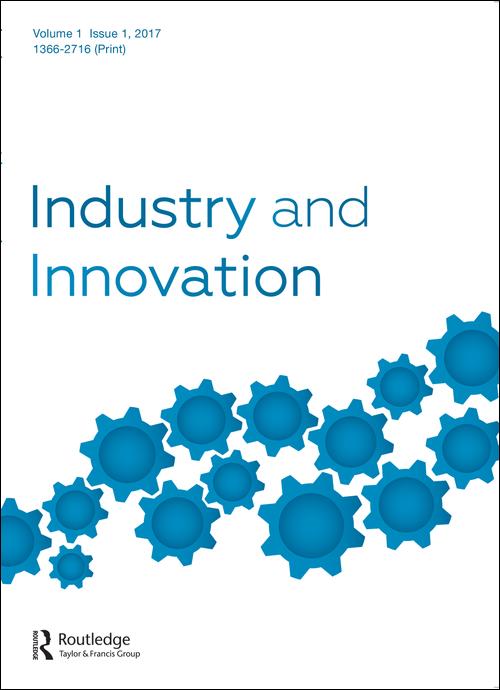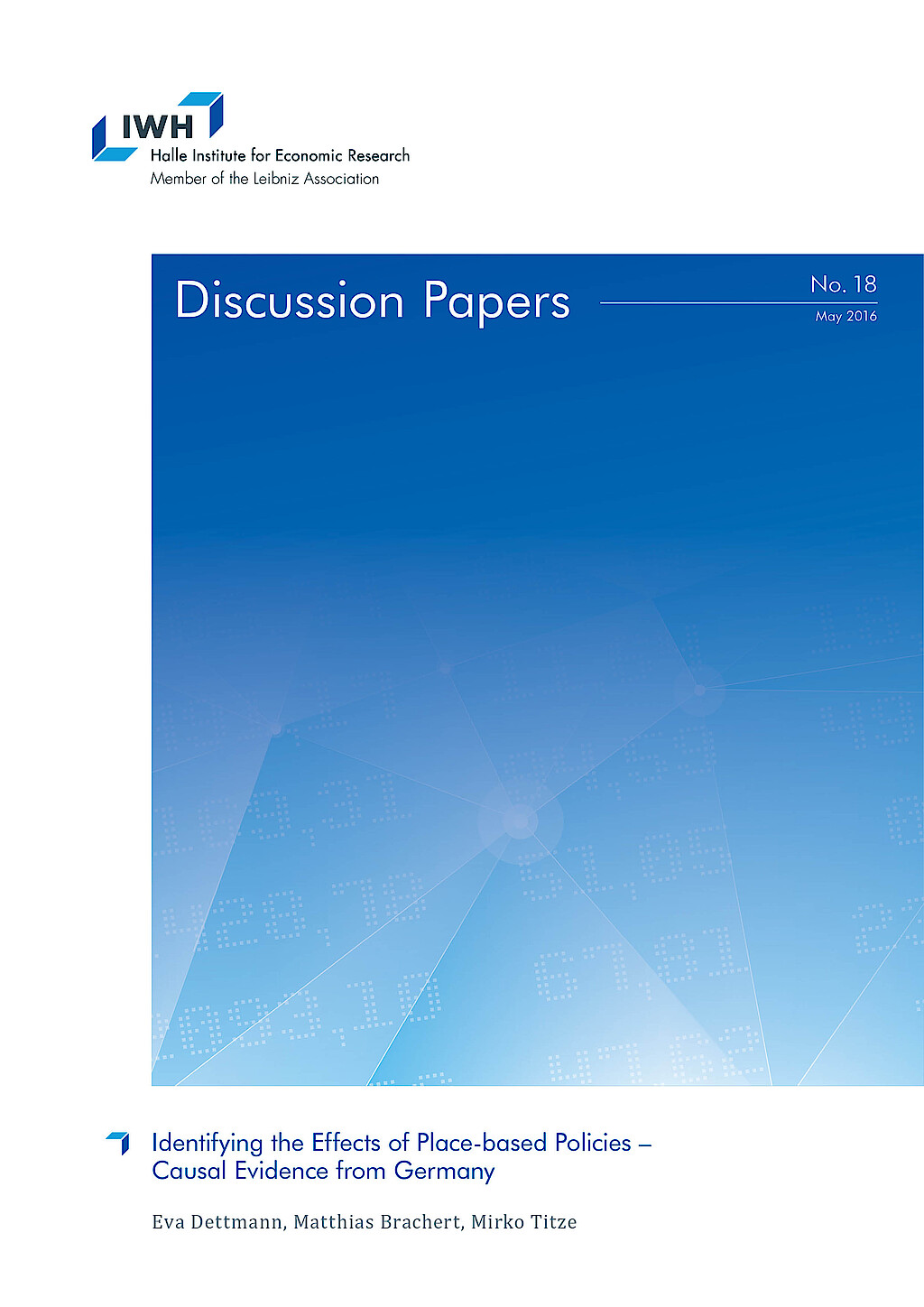Evaluierung von Subventionsprogrammen
Diese Forschungsgruppe untersucht die Effekte von Produktions- und Wissensnetzwerken auf die Produktivität von Unternehmen und Regionen. Darüber hinaus werden Wirkungen staatlicher Förderprogramme für Forschung und Entwicklung sowie regionalpolitischer Programme auf die Leistungsfähigkeit von Unternehmen und Regionen evaluiert.
Zentrum für evidenzbasierte Politikberatung (IWH-CEP)
Forschungscluster
Wirtschaftliche Dynamik und StabilitätIhr Kontakt

- Abteilung Zentrum für evidenzbasierte Politikberatung
PROJEKTE
09.2019 ‐ 09.2022
Etablierung einer evidenzbasierten Evaluationskultur für industriepolitische Fördermaßnahmen in Deutschland (EVA-KULT)
Europäischer Fonds für regionale Entwicklung (EFRE)
Das Vorhaben dient dem Ausbau des Zentrums für evidenzbasierte Politikberatung am Leibniz-Institut für Wirtschaftsforschung Halle (IWH-CEP).
01.2018 ‐ 12.2020
Vernetzt wachsen - Innovatives Sachsen-Anhalt durch digitale Geschäftsmodelle (Kompetenzzentrum 4.0)
Bundesministerium für Wirtschaft und Energie (BMWi)
01.2017 ‐ 12.2018
Politische Partizipation in Ostdeutschland
Bundesministerium für Wirtschaft und Energie (BMWi)
12.2015 ‐ 11.2018
Sozioökonomische Effekte der Erforschung innovativer Ansätze für die POC-Diagnostik
Bundesministerium für Bildung und Forschung (BMBF)
Teilvorhaben im Verbundprojekt “POC-Sensorplattform für chronisch-entzündliche Atemwegserkrankungen (EXASENS)”. Neun Leibniz-Institute arbeiten gemeinsam im Pilotprojekt EXASENS an der Erforschung einer Point-of-Care-Technologie zur Vorhersage und Diagnose von chronisch-entzündlichen Atemwegserkrankungen. Der Verbund wird vom Bundesministerium für Bildung und Forschung (BMBF) mit 6,25 Millionen Euro gefördert und liefert einen Beitrag zum Ausbau und zur Stärkung des Themenfeldes Gesundheitstechnologien.
Vgl. Pressemitteilung des Leibniz-Institut für Photonische Technologien (IPHT), Jena.
02.2017 ‐ 02.2018
Bedeutung außeruniversitärer Forschungseinrichtungen für die Entwicklung von Betrieben und Regionen
Bundesministerium für Bildung und Forschung (BMBF)
01.2015 ‐ 12.2016
Evaluierung der GRW-Förderung in Sachsen-Anhalt
Investitionsbank Sachsen-Anhalt
Referierte Publikationen

Urban Occupational Structures as Information Networks: The Effect on Network Density of Increasing Number of Occupations
in: Plos One, im Erscheinen
Abstract
Urban economies are composed of diverse activities, embodied in labor occupations, which depend on one another to produce goods and services. Yet little is known about how the nature and intensity of these interdependences change as cities increase in population size and economic complexity. Understanding the relationship between occupational interdependencies and the number of occupations defining an urban economy is relevant because interdependence within a networked system has implications for system resilience and for how easily can the structure of the network be modified. Here, we represent the interdependencies among occupations in a city as a non-spatial information network, where the strengths of interdependence between pairs of occupations determine the strengths of the links in the network. Using those quantified link strengths we calculate a single metric of interdependence–or connectedness–which is equivalent to the density of a city’s weighted occupational network. We then examine urban systems in six industrialized countries, analyzing how the density of urban occupational networks changes with network size, measured as the number of unique occupations present in an urban workforce. We find that in all six countries, density, or economic interdependence, increases superlinearly with the number of distinct occupations. Because connections among occupations represent flows of information, we provide evidence that connectivity scales superlinearly with network size in information networks.

Regional Effects of Professional Sports Franchises – Causal Evidence from Four European Football Leagues
in: Regional Studies, Nr. 2, 2021
Abstract
The locational pattern of clubs in four professional football leagues in Europe is used to test the causal effect of relegations on short-run regional development. The study relies on the relegation mode of the classical round-robin tournament in the European model of sport to develop a regression-discontinuity design. The results indicate small and significant negative short-term effects on regional employment and output in the sports-related economic sector. In addition, small negative effects on overall regional employment growth are found. Total regional gross value added remains unaffected.

Entry into Self-employment and Individuals’ Risk-taking Propensities
in: Small Business Economics, Nr. 4, 2020
Abstract
Most of the existing empirical literature on self-employment decisions assumes that individuals’ risk-taking propensities are stable over time. We allow for endogeneity on both sides when examining the relationship between individual risk-taking propensities and entry into self-employment. We confirm that a greater risk-taking propensity is associated with a higher probability of entering self-employment. However, we also find evidence that entering self-employment is associated with a significant and substantial increase in an individual’s propensity to take risks. Our findings add to the growing evidence that risk-taking propensities are not only inborn, but also determined by environmental factors.

Growing Income Inequality in the United States and Other Advanced Economies
in: Journal of Economic Perspectives, Nr. 4, 2020
Abstract
This paper studies the contribution of both labor and non-labor income in the growth in income inequality in the United States and large European economies. The paper first shows that the capital to labor income ratio disproportionately increased among high-earnings individuals, further contributing to the growth in overall income inequality. That said, the magnitude of this effect is modest, and the predominant driver of the growth in income inequality in recent decades is the growth in labor earnings inequality. Far more important than the distinction between total income and labor income, is the way in which educational factors account for the growth in US labor and capital income inequality. Growing income gaps among different education groups as well as composition effects linked to a growing fraction of highly educated workers have been driving these effects, with a noticeable role of occupational and locational factors for women. Findings for large European economies indicate that inequality has been growing fast in Germany, Italy, and the United Kingdom, though not in France. Capital income and education don't play as much as a role in these countries as in the United States.

Identifying Cooperation for Innovation ― A Comparison of Data Sources
in: Industry and Innovation, Nr. 6, 2020
Abstract
The value of social network analysis is critically dependent on the comprehensive and reliable identification of actors and their relationships. We compare regional knowledge networks based on different types of data sources, namely, co-patents, co-publications, and publicly subsidized collaborative R&D projects. Moreover, by combining these three data sources, we construct a multilayer network that provides a comprehensive picture of intraregional interactions. By comparing the networks based on the data sources, we address the problems of coverage and selection bias. We observe that using only one data source leads to a severe underestimation of regional knowledge interactions, especially those of private sector firms and independent researchers.
Arbeitspapiere

Identifying the Effects of Place-based Policies – Causal Evidence from Germany
in: IWH Discussion Papers, Nr. 18, 2016
Abstract
The German government provides discretionary investment grants to structurally weak regions to reduce regional disparities. We use a regression discontinuity design that exploits an exogenous discrete jump in the probability of receiving investment grants to identify the causal effects of the investment grant on regional outcomes. We find positive effects for regional gross value-added and productivity growth, but no effects for employment and gross wage growth.

Do Manufacturing Firms Benefit from Services FDI? – Evidence from Six New EU Member States
in: IWH Discussion Papers, Nr. 5, 2015
Abstract
This paper focuses on the effect of foreign presence in the services sector on the productivity growth of downstream customers in the manufacturing sector in six EU new member countries in the course of their accession to the European Union. For this purpose, the analysis combines firm-level information, data on economic structures and annual national input-output tables. The findings suggest that services FDI may enhance productivity of manufacturing firms in Central and Eastern European (CEE) countries through vertical forward spillovers, and thereby contribute to their competitiveness. The consideration of firm characteristics shows that the magnitude of spillover effects depends on size, ownership structure, and initial productivity level of downstream firms as well as on the diverging technological intensity across sector on the supply and demand side. The results suggest that services FDI foster productivity of domestic rather than foreign controlled firms in the host economy. For the period between 2003 and 2008, the findings suggest that the increasing share of services provided by foreign affiliates enhanced the productivity growth of domestic firms in manufacturing by 0.16%. Furthermore, the firms’ absorptive capability and the size reduce the spillover effect of services FDI on the productivity of manufacturing firms. A sectoral distinction shows that firms at the end of the value chain experience a larger productivity growth through services FDI, whereas the aggregate positive effect seems to be driven by FDI in energy supply. This does not hold for science-based industries, which are spurred by foreign presence in knowledge-intensive business services.

Isolation and Innovation – Two Contradictory Concepts? Explorative Findings from the German Laser Industry
in: IWH Discussion Papers, Nr. 1, 2015
Abstract
We apply a network perspective and study the emergence of core-periphery (CP) structures in innovation networks to shed some light on the relationship between isolation and innovation. It has been frequently argued that a firm’s location in a densely interconnected network area improves its ability to access information and absorb technological knowledge. This, in turn, enables a firm to generate new products and services at a higher rate compared to less integrated competitors. However, the importance of peripheral positions for innovation processes is still a widely neglected issue in literature. Isolation may provide unique conditions that induce innovations which otherwise may never have been invented. Such innovations have the potential to lay the ground for a firm’s pathway towards the network core, where the industry’s established technological knowledge is assumed to be located. The aim of our paper is twofold. Firstly, we propose a new CP indicator and apply it to analyze the emergence of CP patterns in the German laser industry. We employ publicly funded Research and Development (R&D) cooperation project data over a period of more than two decades. Secondly, we explore the paths on which firms move from isolated positions towards the core (and vice versa). Our exploratory results open up a number of new research questions at the intersection between geography, economics and network research.

Does Proximity Matter in the Choice of Partners in Collaborative R&D Projects? – An Empirical Analysis of Granted Projects in Germany
in: IWH Discussion Papers, Nr. 12, 2014
Abstract
This paper contributes to the discussion on the importance of physical distance in the emergence of cross-region collaborative Research and Development (R&D) interactions. The proximity theory, and its extensions, is used as a theoretical framework. A spatial interaction model for count data was implemented for the empirical analysis of German data from the period from 2005 to 2010. The results show that all tested proximity measurements (geographical, cognitive, social and institutional proximity) have a significant positive influence on collaboration intensity. The proximity paradox, however, cannot be confirmed for geographical, social and institutional proximity, but for cognitive proximity.

Is Subsidizing Companies in Difficulties an Optimal Policy? An Empirical Study on the Effectiveness of State Aid in the European Union
in: IWH Discussion Papers, Nr. 9, 2014
Abstract
Even though state aid in order to rescue or restructure ailing companies is regularly granted by European governments, it is often controversially discussed. The aims for rescuing companies are manifold and vary from social, industrial and even political considerations. Well-known examples are Austrian Airlines (Austria) or MG Rover (Great Britain). Yet, this study aims to answer the question whether state aid is used effectively and whether the initial aim why aid has been paid has been reached, i.e. the survival of the company. By using data on rescued companies in the EU and applying a survival analysis, this paper investigates the survival rates of these companies up to 15 years after the aid has been paid. In addition, the results are compared to the survival rates of non-rescued companies which have also been in difficulties. The results suggest that despite the financial support, business failure is often only post-poned; best survival rates have firms with long-term restructuring, enterprises in Eastern Europe, smaller firms and mature companies. However, non-funded companies have an even higher ratio to go bankrupt.













